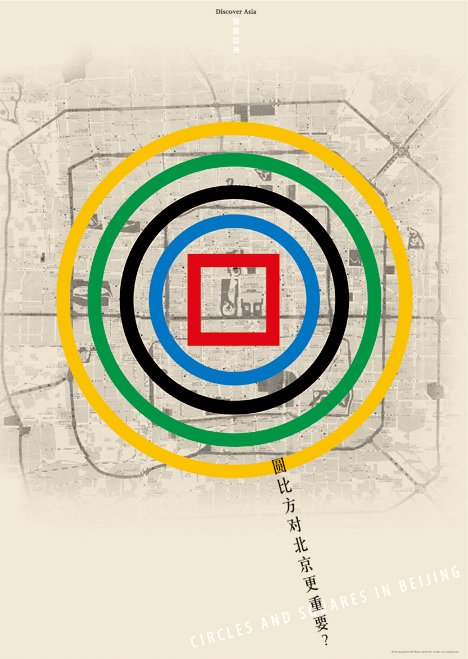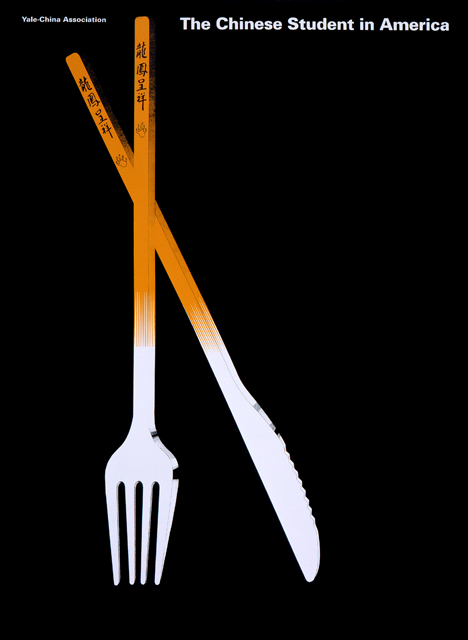MIN WANG
Why did you leave Adobe Systems in 1998 to start your own design firm, Square Two Design?
I started to work for Adobe as an intern in 1986 when the size of the company was around 30 people then and all the way through as a senior designer, senior art director, and the design manager in charge of the company’s design department and team. I learned a lot in these years, such as corporate marketing and communication, branding, interface and web design, etc. But as designer, I never had an experience to run an independent design studio of my own. In 1998, the dot com boom was on in Silicon Valley. Eddie Lee, a former schoolmate of mine at Yale, offered me the chance to join Square Two Design as a partner. And it was a time I was looking for a change in my life and work, and it happened.

Circles and Squares in Beijing, Discover Asia poster, 2002
When did you decide to return to China and for what reasons?
After studying, teaching and working in Europe and the United States for twenty years, I made the decision to come back to China to focus my work on two things: design education and design for the 2008 Beijing Olympic Games.
In less than ten years, China has quickly added more than a thousand design schools and programs that enroll hundred of thousands of students at the university and college level. But how to teach design in China, how to learn but not to copy the West, and how to find design expression in an Eastern aesthetic sense and sensibility, these have become big questions. I came back to China intending to face, ask and solve these questions.
As a Chinese designer educated both in China and the West, I feel being very fortunate to be the current Dean of the School of Design at CAFA, a position that enables me to make an impact in the field of design education in China today. The students at CAFA today will be the future leaders and educators in China’s design field tomorrow. It is in them, we invest the hopes and directions of design in China and in the future.

Chinese Student Poster
If you were to identify the strengths and weaknesses in Chinese graphic design education, what would you include?
The strength of China’s design education comes from its market demand and job opportunities for students. We also have a large pool of enthusiastic and talented younger generation of students who are eager to enter the field. However, our strength is also our weakness. We are in great lack of good design teachers and design education became very commercialized, short-term, utilitarian, and technically driven. Everyone wants to get results or rewards fast, and a good and solid design education and design curriculum cannot be based on that. Except for a few top schools and design education departments, many schools, despite their lack of teaching staff and curriculum development, quickly expanded their student enrollment or added design departments and majors. The result is the production line of graduates who do not understand good design from bad design, original creativity from copying, and some basic principles and concepts of graphic design. Thus, I think that design education is a fresh, confused, and a chaotic field right now. The quality of design education varies greatly depending on schools, departments, faculty members, and student recruitments.
What do you envision as the next development in Chinese graphic design, particularly with the ever-expanding economy in mainland China? Are you optimistic about the future of Chinese graphic design and the younger generation of graphic designers?
We consider ourselves as the “older” generation of Chinese graphic designers coming to the forefront as a result of China’s open policy to a market economy and reform in the last 25 years. The top team of Chinese graphic designers, people like Wang Xu and some others in Zhenzhen, as well as a group of very talented younger generation of designers, people like Chen Zhengda in Hangzhou, Miwi Studio and Jiang Hua in Beijing, are recognized by the international design community today and their work is just as excellent, sophiscated, and individualistic, like any other top graphic designers in the world. However, compared to many western countries as well as some Asian countries like Japan, the overall design education and design standard still fall behind.
Design for the 2008 Olympic Games is a great opportunity for us, through which we can combine design education with real world practices, blending East and West, and Chinese tradition and international modernity. The challenges we face and the solutions we are finding in design for the 2008 Beijing Olympic Games, to a large extent, reflect the challenges and solutions Chinese designers face today. I hope through the high exposure and good quality of design, we not only bring Chinese designers to the world platform, but also bring the best international designers to China.
I had applied to ICOGRADA (The International Council of Graphic Design Association) to host the ICOGRADA World Design Congress 2009 in Beijing and the China Central Academy of Fine Arts (CAFA) will be the main organizer. The conference should attract around 3,000 attendees. It will be a great event for designers from all over the world to meet with Chinese designers, to exchange their ideas, their works.
Square Two
Address: No. 8 Hua Jia Di Nan Jie, Chao Yang District, Beijing 100102
Tel: +86 1350 1084 543
mwang@square2.com
https://www.square2.com
Text: Richard B. Doubleday, Stephen Goldstein
Photos: Courtesy of Min Wang





